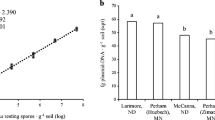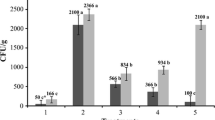Abstract
Pre-harvest chemical applications significantly reduced populations of viableAlternaria solani spores on the soil surface in the laboratory and field and the infection of potato tubers in the field. Only formaldehyde consistently reduced spore germination and tuber infection in the laboratory and the field but Difolatan 4F, Difolatan 4F + DMSO (dimethyl-sulfoxide), Manzate D, Manzate D + DMSO and sodium hypochlorite often reduced fungus populations significantly. More work is necessary before pre-harvest chemical applications can be recommended for control of early blight tuber decay due to the variable performance of many chemicals and the relatively high cost and corrosiveness of formaldehyde, the most effective chemical in the study.
Resumen
Aplicaciones químicas antes de la cosecha redujeron significativamente las poblaciones de esporas viables de Alternaria solani en la superficie del suelo en laboratorio y campo y también la infección de los tubérculos de papa en el campo. Sólo el formaldehido redujo la germinación de las esporas consistentemente y la infección de los tubérculos en laboratorio y campo. Difolatan 4F, Difolatan 4F + DMSO (dimethylsulfoxide), Manzate D, Manzate D + DMSO e hypoclorito de sodio, redujeron a menudo la población del hongo significativamente. Más trabajo es necesario antes de que la aplicación quimica pre-cosecha pueda ser recomendada para controlar la pudrición de los tubérculos por tizón tardio debido a la performance variable de varios quimicos y el costo relativamente alto y corrosividad del formaldehido, el quimico más efectivo en este estudio.
Similar content being viewed by others
Literature Cited
Douglas, D.R. and J.J. Pavek. 1971. An efficient method of inducing sporulation ofAlternaria solani in pure culture. Phytopathology 61:239.
Folsom, D. and R. Bonde. 1925.Alternaria solani as a cause of tuber rot in potatoes. Phytopathology 15:282–286.
Gratz, L.O. and R. Bonde. 1927. Infection of potato tubers byAltemaria solani in relation to storage conditions. Fla Agric Exp Stn Bull 187:167–182.
Harrison, M.D. and C.H. Livingston. 1966. A method for isolatingVerticillium from field soil. Plant Dis Rep 50:897–899.
Nadakavukaren, M.J. and C.E. Horner. 1959. An alcohol agar medium selective for determiningVerticillium microsclerotia in soil. Phytopathology 49:527–528.
Richardson, L.T. and D.E. Munnecke. 1964. Effective fungicide dosage in relation to inoculum concentration in soil. Can J Bot 42:301–306.
Venette, J.R. 1969. An epidemiological study of tuber infection byAlternaria solani. M.Sc. Thesis, Dept. of Botany and Plant Pathology, Colorado State University. 107 p.
Venette, J.R. and M.D. Harrison. 1973. Factors affecting infection of potato tubers byAlternaria solani in Colorado. Am Potato J 50:283–292.
Author information
Authors and Affiliations
Additional information
Published with the approval of the Director, Colorado State University Experiment Station as Scientific Journal Series Paper Number 2721.
Partially supported by the Area 3 Potato Administrative Committee, Greeley, Colorado 80631.
Rights and permissions
About this article
Cite this article
Lahman, L.K., Harrison, M.D. & Knutson, K.W. Pre-harvest chemical applications for control of tuber infection byAlternaria solani . American Potato Journal 59, 523–532 (1982). https://doi.org/10.1007/BF02852601
Received:
Issue Date:
DOI: https://doi.org/10.1007/BF02852601




